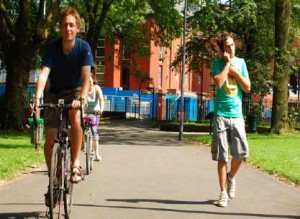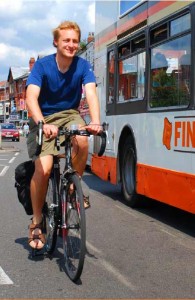Keeping safe on the roads
Cycling know how by Olly Glover
Some of our members met up with London Cycling Campaign (www.lcc.org.uk) at the Cycle Show. We asked the team at LCC to give us some tips on riding in traffic.
Be seen clearly
One of the key principles of safe cycling is to ride in a prominent position on the road where you can be clearly seen. By avoiding cycling close to the kerb or edge of the road, you give yourself more room to manoeuvre. This not only makes you more visible to drivers, but also makes it less likely you will hit drain covers or potholes. It is advisable to ride at least one metre away from the edge of the road.
Wear suitable clothing
Wearing suitable, comfortable clothing and using front and back lights also increases your visibility to other road users. By showing general awareness of the vehicles around you, and your position on the road, your cycling experience should be safe and trouble-free.
Cycling with pedestrians
 If you are cycling on a path signposted for shared use with pedestrians, you should show consideration by cycling at an appropriate speed and giving way at all times. You should alert pedestrians
If you are cycling on a path signposted for shared use with pedestrians, you should show consideration by cycling at an appropriate speed and giving way at all times. You should alert pedestrians
to your presence if there is any risk of a collision by sounding your bell or giving a polite verbal warning.
Pedestrians can feel threatened when people cycle close to them. Some parks and open spaces have segregated cycle and pedestrian paths. Some pedestrians may not understand this and walk on the cycle path. Cycle with consideration and be prepared to slow down.
Overtaking motor vehicles
It is often necessary to overtake stationary or slow-moving vehicles in traffic. Whatever the circumstances, watch for pedestrians stepping through lanes of traffic or car doors opening as you pass. When you overtake it is important to be aware of what is around you.
 When overtaking parked vehicles, take a look behind you (over your right shoulder). If it is clear, signal and pull out towards the middle of the road. Leave at least one metre between yourself and the parked vehicle to allow for the hazard of an opening door. If you are not crossing over a lane marking during the manoeuvre, you have right of way over the vehicles behind you.
When overtaking parked vehicles, take a look behind you (over your right shoulder). If it is clear, signal and pull out towards the middle of the road. Leave at least one metre between yourself and the parked vehicle to allow for the hazard of an opening door. If you are not crossing over a lane marking during the manoeuvre, you have right of way over the vehicles behind you.
When overtaking a slow-moving vehicle, you should again take a look over your right shoulder before signalling and pulling out. You should also check for oncoming traffic to ensure there is no risk of collision.
Cycling near lorries and HGVs
The draught of a large vehicle such as an articulated lorry can be a hazard for a cyclist if it passes too close. Positioning yourself well out from the kerb and taking the centre of the lane where necessary will leave you more room for manoeuvre. Lorries turning left are the most dangerous hazard to cyclists. Remember that large lorries may move out to the right before they unexpectedly turn left at a junction.
Never edge forward alongside a long vehicle, even if there is a cycle lane, as you may be trapped when it turns, leaving you no escape route. The presence of pedestrian guard railings increases the danger by blocking your escape route.
Remember that it is also difficult for drivers of larger vehicles to see cyclists. With this in mind, keep well behind a lorry in front and position yourself so that you can be seen in its side mirrors – if you can’t see its mirrors, its driver cannot see you. It is particularly easy for your presence to go unnoticed at busy junctions and gyratory systems.

